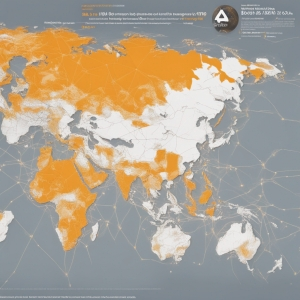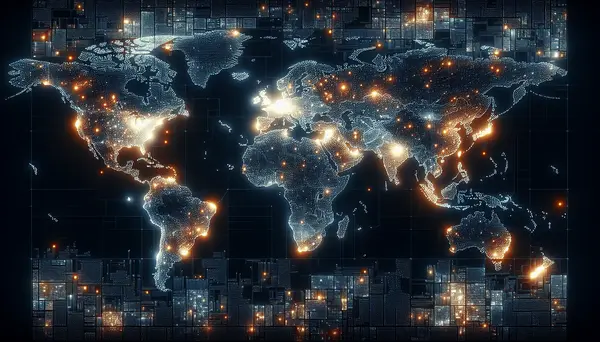Table of Contents:
Bitcoin mining, the engine behind creating new bitcoins and validating transactions, has evolved into a competitive global industry. This article will serve as an introductory guide to the global distribution of Bitcoin miners, shedding light on where mining takes place, who the key players are, and why certain geographical hotspots have become popular. By understanding the logistics of Bitcoin mining, you can increase your knowledge of the cryptocurrency market as a whole and make more informed decisions about your own cryptocurrency investments.
Introduction to Global Distribution of Bitcoin Miners
Bitcoin mining is not just a single computer process but rather a network of thousands of computers located all over the world. This global web of miners works together, or sometimes in competition, to solve complex mathematical problems that generate new bitcoins and validate transactions on the blockchain.
Get $500 free Bitcoin mining for a free testing phase:
- Real daily rewards
- 1 full month of testing
- No strings attached
If you choose to buy after testing, you can keep your mining rewards and receive up to 20% bonus on top.
Over the years, the distributive nature of Bitcoin mining has changed significantly. The distribution of Bitcoin miners is heavily influenced by geographical, political, and economic factors including energy costs, regulatory environments, and availability of technological infrastructure. This distribution doesn't only affect the creation and validation of transactions, but can directly impact the speed, security, and decentralization of the Bitcoin network.
For those looking to fully grasp the structural setup of the Bitcoin network, understanding the global distribution of Bitcoin miners is an integral part of financial literacy in this digital age. Whether you are an investor, a tech enthusiast, or a beginner in the crypto space, this comprehensive guide will help you appreciate the global breadth and intricacies of Bitcoin mining.
Understanding Bitcoin Mining
At its core, Bitcoin mining is the process of using computers to solve complex mathematical problems, known as 'proof of work.' Each solution creates a block that is added to the Bitcoin blockchain, essentially recording Bitcoin transactions. The miner that solves the problem receives newly minted bitcoins as a reward, hence the term "mining."
Different mining technologies play a role in this process, with the most common being Application-Specific Integrated Circuits (ASICs), and to a lesser extent, Graphics Processing Units (GPUs). Each of these mining technologies comes with its own sets of pros and cons regarding efficiency, cost, and power consumption.
The mining process is deliberately designed to be difficult and resource-intensive to maintain the decentralized nature of the blockchain and control the supply of new bitcoins. As the bitcoin network grows and evolves, so too does the mining process. Thus, the global distribution of Bitcoin miners changes as miners adjust their operations to stay profitable.
This rise in competition among miners for the block reward, coupled with fluctuating energy costs and ever-evolving regulatory landscapes, is shifting the global distribution and dominance of Bitcoin mining operations.
Bitcoin Mining Distribution: Key Players and Geo-Hotspots
| Country | Percentage of Global Bitcoin Mining (%) | Pros | Cons |
|---|---|---|---|
| China | 65 | Abundant cheap energy, advanced hardware, government incentives | Regulatory risks, environmental concerns |
| USA | 7 | Increasing investment, regulatory clarity | Higher energy costs, less government support |
| Russia | 6 | Low-cost energy, government tolerance | Political tension, unclear regulations |
| Kazakhstan | 6 | Low electricity costs, gov incentives | Regulatory uncertainties, infrastructure issues |
| Malaysia | 4 | Favorable climate, abundant energy | Regulatory uncertainty, environmental impact |
Key Players in Bitcoin Mining

The Bitcoin mining scene has always been dynamic with several key players shaping its landscape. These include mining pools, solo miners, and bitcoin farms. Among the biggest are F2Pool, Poolin, and Antpool. They are well established and contribute substantially to the global hash power, the measurement of computational power in the Bitcoin network.
Many of these dominant players hail from countries with abundant resources, low electricity cost and a favourable regulatory environment for Bitcoin mining, such as China, United States, Russia, and Kazakhstan. In particular, China has been a significant player, housing the headquarters of many leading mining companies and pools. In recent years, the United States has made significant strides towards increasing its share of global hash power.
Bitcoin mining has, however, been shaken up recently due to changing geopolitical considerations, such as China's crackdown on cryptocurrency activities and the corresponding migration of miners to more crypto-friendly territories. This situation is reshaping the distribution of key players in Bitcoin mining.
Understanding the nature of these players, their methodologies, and their geographical preferences can provide crucial context to the evolving Bitcoin mining trends and create a broader understanding of the state of Bitcoin on a global scale.
Geographical Hotspots for Bitcoin Mining
Geographically, the spread of Bitcoin mining centers primarily falls into regions with three crucial factors: low energy costs, favorable governmental policies, and access to mining hardware. As such, areas with inexpensive and abundant electricity supply, such as hydroelectric power, tend to attract Bitcoin miners.
Historically, China dominated Bitcoin mining due to its cheap electricity, local chipmaking factories, and lenient regulations. However, with recent policy changes leading to a crackdown on cryptocurrency mining, many Chinese miners have relocated, seeking more welcoming environments. This migration has caused a shift in the distribution of Bitcoin miners globally.
The United States, particularly the states of Texas and Wyoming, has recently seen an influx of Bitcoin mining operations. These regions not only offer relatively low energy costs but also feature a more friendly regulatory environment for cryptocurrencies. Furthermore, the U.S. is home to several high-tech mining hardware manufacturers, which increases its attractiveness for miners.
Other notable hotspots include regions in Kazakhstan, Russia, and Iran. These areas have low electricity prices and cold weather, which is ideal for Bitcoin mining, as cooling costs are a substantial part of a mining operation's expenses.
It is also important to note the rise of 'green mining' operations. Certain geographical locations, like Iceland and parts of Canada, are becoming attractive due to their access to renewable energy sources and naturally cool climate, which aligns with the industry's increasing push towards environmentally friendly Bitcoin mining.
Impact of Bitcoin Mining Distribution on the Crypto Market

The global distribution of Bitcoin miners has a profound impact on the overall cryptocurrency market. It influences several fundamental aspects of Bitcoin, including its availability, investment attractiveness, price volatility, and more. Here is an overview:
1. Network Security: A diverse and decentralized network of miners contributes to the security and resilience of the Bitcoin network. Each miner in the network acts as a node where Bitcoin transactions are verified and recorded. The more distributed these miners are, the more secure and reliable is the Bitcoin network.
2. Transaction Speed and Cost: The geographical distribution of miners can influence transaction speed. Miners closer to where a transaction is initiated can confirm it faster than those further away. Consequently, regions with a high concentration of miners might see quicker transaction times.
3. Market Availability and Price: Mining injects new bitcoins into the market, affecting the overall availability. High mining activity in a region can create a surplus of Bitcoin, potentially lowering its price. On the contrary, restricted mining can create a shortage, possibly increasing the price.
4. Regulatory Impact: As regulatory stances on Bitcoin mining vary greatly worldwide, this has a direct effect on its distribution. Harsher regulations can discourage mining activities within a particular jurisdiction, while crypto-friendly laws can attract miners, influencing the geographical hotspots of Bitcoin mining. This in turn can affect the global crypto market.
Fazit
Understanding the global distribution of Bitcoin miners is crucial for anyone involved or interested in the cryptocurrency universe. Whether as an investor, enthusiast, or beginner, having comprehensive knowledge of who the significant players are, where they are located, and why they choose specific geographical hotspots can provide a vivid picture of the Bitcoin mining industry and its future. Over time, as technology advances and regulations evolve, so too will the landscape of Bitcoin mining. Staying informed about these changes is essential to navigate the cryptocurrency market effectively. While the landscape may seem complex, the visualized global distribution of Bitcoin miners and its impact on the crypto market provides fascinating insights into the ever-evolving world of Bitcoin.
Conclusion: Global Distribution of Bitcoin Miners and Future Predictions

In conclusion, the global distribution of Bitcoin miners is a fascinating landscape marked by swift changes and intense competition. In no small measure, this distribution depends heavily on the interplay of diverse factors, such as energy costs, technological access, and government regulation.
As of today, key players have emerged from across the globe, with hotspots identified in China, United States, Russia, and Kazakhstan. Nonetheless, the dynamism of Bitcoin and its underlying technology, coupled with shifting regulatory landscapes, ensures that the global map of Bitcoin mining remains fluid.
Moving forward, the mining industry's future will likely continue to evolve. Trends indicate a potential increase in geographical distribution as more countries, motivated by economic gains and technological advancements, exploit low-cost energy resources and adopt more crypto-friendly regulations.
For stakeholders in the Bitcoin sphere and potential investors, understanding the global distribution of Bitcoin miners is crucial. It provides immense clarity on the factors that drive this market, decisively shaping Bitcoin's availability, decentralization, and security aspects. By keeping a close watch on these factors, one can make informed and astute decisions, whether for current mining practices or potential future investments in the Bitcoin mining industry.
FAQs About Global Bitcoin Mining Distribution
Where are the key geographical hotspots for Bitcoin mining?
Key geographical hotspots for Bitcoin mining are located in China, USA, Russia, Kazakhstan, and Malaysia.
Who are the key players in Bitcoin mining?
Key players in the Bitcoin mining are Bitmain, MicroBT, Canaan, F2Pool and Poolin.
Why is geographical distribution important in Bitcoin mining?
Geographical distribution is important because the energy cost, climate, and policy of a region can significantly impact the efficiency and profitability of Bitcoin mining.
What impact does Bitcoin mining have on the environment?
Bitcoin mining can have significant environmental impact due to its high energy consumption which often relies on fossil fuels. It is estimated to use more electricity annually than some countries.
What are the challenges faced by Bitcoin miners?
Bitcoin miners face challenges such as high energy costs, access to cheap and renewable energy, regulatory changes, and the increasing difficulty level of Bitcoin mining.






